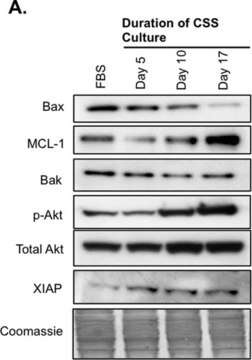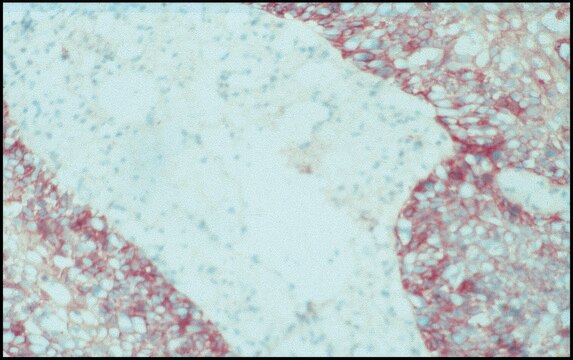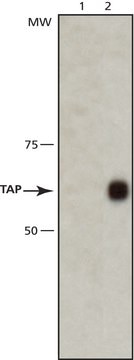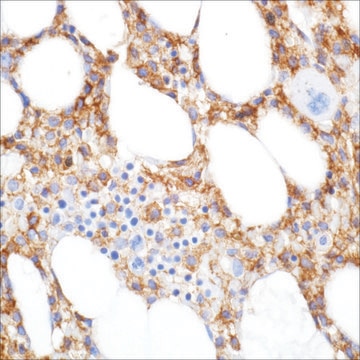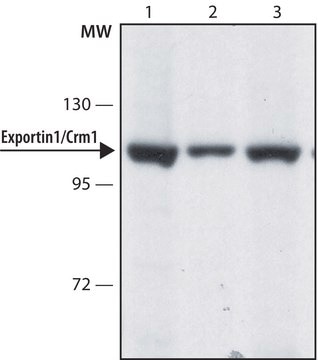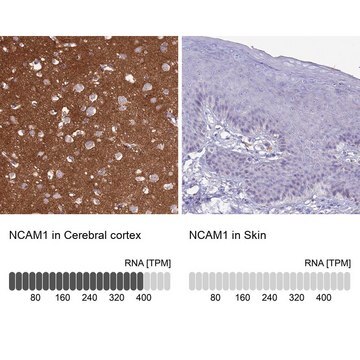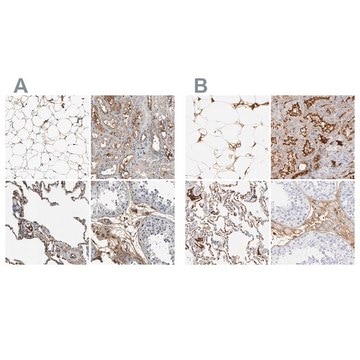ABS1626
Anti-Exportin-1/CRM1 Antibody
serum, from rabbit
Synonym(s):
Exportin-1, Exp1, Chromosome region maintenance 1 protein homolog, Exportin-1/CRM1
About This Item
Recommended Products
biological source
rabbit
Quality Level
antibody form
serum
antibody product type
primary antibodies
clone
polyclonal
species reactivity
human, monkey, mouse
technique(s)
electron microscopy: suitable
immunocytochemistry: suitable
immunoprecipitation (IP): suitable
western blot: suitable
NCBI accession no.
UniProt accession no.
shipped in
dry ice
target post-translational modification
unmodified
Gene Information
human ... XPO1(7514)
General description
Immunogen
Application
Immunoprecipitation Analysis: A representative lot detected enhanced Crm1 association with Nup62, Nup153, and Ran in HeLa cells upon diethyl maleate (DEM) treatment by co-IP (Crampton, N., et al. (2009). Mol Biol Cell. 20(24):5106-5116).
Western Blotting Analysis: A representative lot detected reduced Crm1 level in lysates from HeLa cells upon nuclear export inhibitor leptomycin B (LMB) or oxidant diethyl maleate (DEM) treatment (Crampton, N., et al. (2009). Mol Biol Cell. 20(24):5106-5116).
Electron Microscopy: A representative lot detected Crm1 nuclear localization in HeLa-derived HtTA-1 cells by EM (Fornerod, M., et al. (1997). EMBO J. 16(4):807-816).
Immunoprecipitation Analysis: A representative lot immunoprecipitated Crm1 from COS-7 cell lysates (Boyle, S.M., et al.(1999). J Virol. 73(8):6872-6881).
Signaling
Signaling Neuroscience
Quality
Western Blotting Analysis: A 1:10,000 of this antibody detected Exportin-1/CRM1 in 10 µg of HeLa cell lysate.
Target description
Physical form
Storage and Stability
Handling Recommendations: Upon receipt and prior to removing the cap, centrifuge the vial and gently mix the solution. Aliquot into microcentrifuge tubes and store at -20°C. Avoid repeated freeze/thaw cycles, which may damage IgG and affect product performance.
Other Notes
Disclaimer
Not finding the right product?
Try our Product Selector Tool.
wgk_germany
WGK 1
flash_point_f
Not applicable
flash_point_c
Not applicable
Certificates of Analysis (COA)
Search for Certificates of Analysis (COA) by entering the products Lot/Batch Number. Lot and Batch Numbers can be found on a product’s label following the words ‘Lot’ or ‘Batch’.
Already Own This Product?
Find documentation for the products that you have recently purchased in the Document Library.
Our team of scientists has experience in all areas of research including Life Science, Material Science, Chemical Synthesis, Chromatography, Analytical and many others.
Contact Technical Service